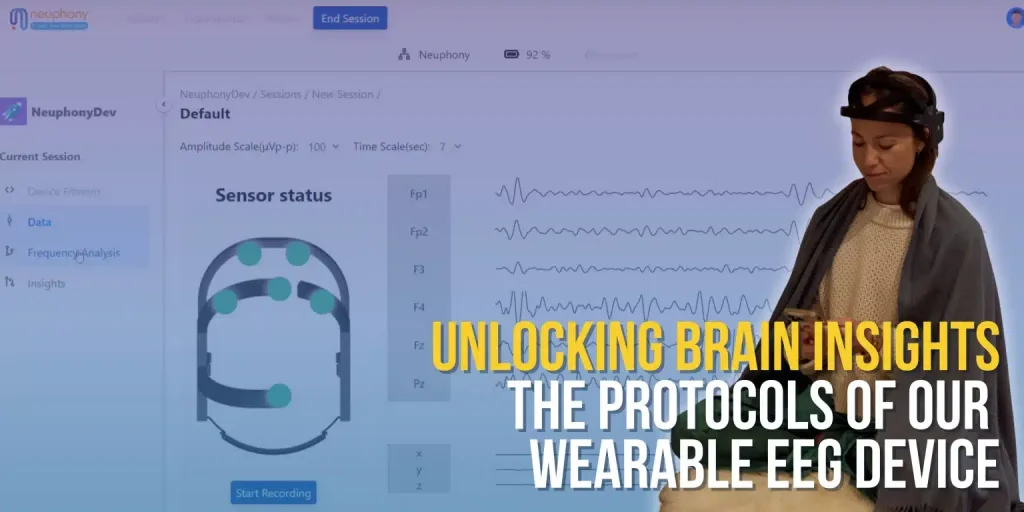
In the field of neuroscience, EEG (electroencephalogram) technology has become a valuable tool for measuring and recording the brain’s electrical signals. It offers valuable insights into brain activity, aiding in the diagnosis and monitoring of various brain-related conditions.
In this blog, we will explore the protocols provided by our brain wearable EEG device, which goes beyond traditional applications and provides data on the basis of four parameters: focus, stress, vigilance, and fatigue. By harnessing the power of EEG technology, we can gain a deeper understanding of these cognitive processes and optimize our performance and well-being.
FOCUS
Focus is a vital cognitive skill that enables individuals to initiate tasks without delay and sustain their attention until completion. It involves having a clear visual definition and center of interest while filtering out distractions. There are two types of focus. Internal focus directs attention towards body movement and conscious awareness of performance, while external focus focuses on the effect of movement on the environment or the end goal.
Research suggests that instructions or feedback promoting external focus can improve performance and learning outcomes. External focus engages automatic control processes, leading to more efficient, fluid, and accurate movements Developing the ability to focus correctly in the right area during tasks offers numerous benefits and helps identify limiting factors that affect performance and development.
STRESS
Stress is a state of fear or psychological strain caused by difficult circumstances. It is an innate reaction that makes us confront potential risks and obstacles. While everyone experiences stress to some degree, how we respond to it impacts our overall well-being. The human body is designed to react to stress by inducing physical and mental symptoms.
Stress responses help us adapt to new situations and can be beneficial by keeping us alert and motivated. However, stress becomes problematic when stressors persist without relief or relaxation periods. Stress can interfere with relaxation, leading to emotions like anxiety and irritability, difficulty concentrating, physical symptoms such as headaches or stomach issues, disrupted sleep, changes in appetite, and increased reliance on substances like alcohol or tobacco.
Long-term stress can aggravate already existing medical issues and contribute to mental health issues like anxiety and depression, which may need professional assistance. Stress relievers can play a crucial role in restoring a sense of calm and serenity to our lives amid chaotic circumstances.
FATIGUE OR COGNITIVE LOAD
Fatigue, or in cognitive psychology, the term “cognitive load,” describes how much working memory is allocated to a given task. There are three types of cognitive load. Extraneous cognitive load has to do with how information or tasks are presented to a learner, whereas intrinsic cognitive load is the effort related to a specific topic. and Germane cognitive load involves building a long-term knowledge base.
While not all cognitive load is detrimental, problems arise when the load exceeds a person’s processing capacity. Cognitive load theory helps us understand how people learn and store new information and guides instructional practices that support learning.
Working memory has limited capacity, and excessive cognitive load can overwhelm learners, leading to frustration or comprehension difficulties. However, some level of cognitive load is necessary for learning, as learners can benefit from challenges and difficulties.
VIGILANCE
Vigilance refers to the ability to maintain concentrated attention over extended periods while searching for a specific target stimulus. It is associated with sustained attention and cognitive performance. Vigilance is crucial in various domains, including human-computer interaction systems and tasks that require monitoring and detecting rare events.
It has grown more significant as a result of technology and automation. Vigilance is considered an essential component of management, comparable to other organizational segments.
Attention and vigilance can be influenced by environmental and physiological factors. Training and practice can improve vigilance and task performance by reducing the vigilance decrement and false alarm rate. Performance improvements are typically observed within the first few hours of training.
CONCLUSION
The protocols provided by our brain-wearable EEG device open up new avenues for understanding and optimizing cognitive processes. From enhancing focus to managing stress, maintaining vigilance, and managing cognitive load, this technology empowers individuals and organizations to unlock their full potential. By leveraging the insights gained from EEG analysis, we can make informed decisions to improve our well-being, performance, and overall quality of life.

